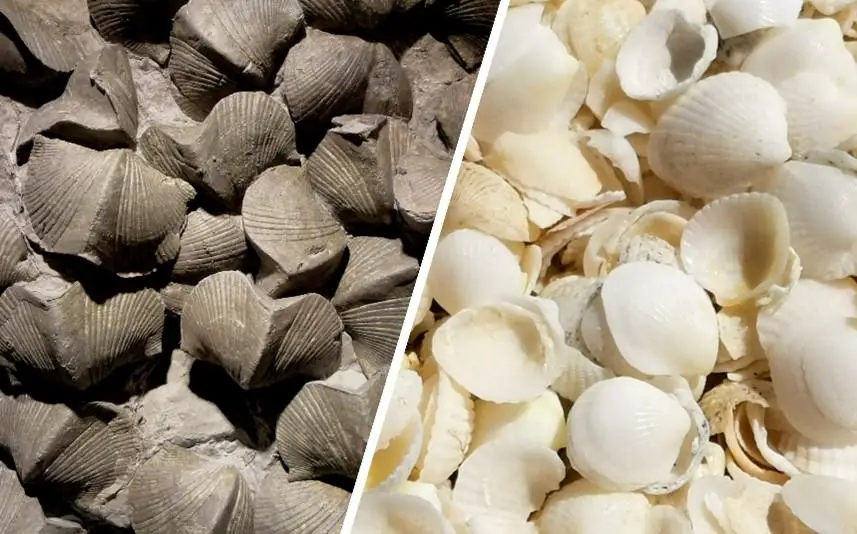The Extended Version of the Text:
A pivotal moment in the history of Earth, characterized by a remarkable shift in the dominance of marine shellfish, witnessed the widespread replacement of brachiopods, often referred to as ‘lamp shells,’ by bivalve species such as oysters and clams. This transformative event was a consequence of the catastrophic end-Permian mass extinction, which effectively reset the course of life approximately 250 million years ago.
Conducted by a team of paleontologists hailing from Bristol, UK, and Wuhan, China, recent research has cast a new and illuminating perspective on this significant turnover, marking the transition from ancient-style to modern-style ocean ecosystems.
Life, both on land and in the depths of the sea, teems with a rich variety of organisms, giving rise to unique ecosystems. In today’s oceans, the seafloor is primarily populated by creatures like bivalves, gastropods, corals, crustaceans, and fishes. However, these vibrant ecosystems trace their origins back to the Triassic period when life staged a remarkable comeback from the brink of extinction. During that critical juncture, a mere one in twenty species managed to endure, sparking prolonged debates about how these new ecosystems took shape and why some groups survived while others succumbed.
Brachiopods once reigned supreme among shelled animals before the extinction event. However, bivalves not only endured but thrived afterward, displaying a remarkable adaptability to their newly emerging environmental conditions.
Zhen Guo, a leading figure in the project from Wuhan and Bristol, elaborated, “A classic case has been the replacement of brachiopods by bivalves. Paleontologists used to posit that bivalves outcompeted brachiopods, thereby prevailing during this crisis period. There’s no denying that brachiopods constituted the dominant group of shelled creatures before the extinction, with bivalves assuming dominance thereafter.”
To unravel the intricate interactions between brachiopods and bivalves over their extensive history, particularly during the critical Permian-Triassic transition, the team opted for a computational approach known as Bayesian analysis. This method allowed them to calculate rates of origination, extinction, and fossil preservation, shedding light on whether these two groups interacted with one another. Did the ascent of bivalves trigger the decline of brachiopods?
“We discovered that, in reality, both groups exhibited similar diversification dynamics throughout the crisis period,” noted Professor Michael Benton from Bristol’s School of Earth Sciences. “This suggests that they were not necessarily competing or preying on each other but likely responding to analogous external factors, such as sea temperature fluctuations and transient crises. Nevertheless, bivalves eventually emerged victorious, while brachiopods retreated to deeper waters, where they still exist, albeit in reduced numbers.”
Professor Zhong-Qiang Chen of Wuhan added, “It was truly fascinating to witness how modern computational methods could address a longstanding question. We had long believed that the end-Permian mass extinction sounded the death knell for brachiopods, but it appears that both brachiopods and bivalves suffered severe setbacks during the crisis and rebounded during the Triassic. However, bivalves exhibited superior adaptability to high ocean temperatures, granting them a competitive edge. Consequently, their numbers skyrocketed after the Jurassic, while brachiopods remained relatively stagnant.”
Zhen Guo described the extensive efforts required for the study, saying, “I had to meticulously compile records of over 330,000 fossils of brachiopods and bivalves spanning the study period. Subsequently, I conducted the Bayesian analysis, which entailed weeks upon weeks of computation on the Bristol supercomputer. Although laborious, I appreciate this method because it systematically addresses uncertainties in the data, offering a wealth of valuable insights into the past.”
Professor Benton concluded, “The end-Permian mass extinction stands as the most colossal extinction event in the annals of Earth’s history, causing a profound reset in the trajectory of evolution. In the 50 million years following this crisis, during the Triassic, life on land and in the sea underwent a remarkable revolution. Understanding how life rebounded from the brink of annihilation and laid the groundwork for the ecosystems we recognize today remains one of the most intriguing questions in the realm of macroevolution. Undoubtedly, there is much more to uncover on this front.”
Table of Contents
Frequently Asked Questions (FAQs) about Permian-Triassic Mass Extinction
What was the key finding of the research on brachiopods and bivalves after the end-Permian mass extinction?
The research found that after the end-Permian mass extinction, both brachiopods and bivalves experienced setbacks but rebounded during the Triassic period. However, bivalves demonstrated superior adaptability to high ocean temperatures, allowing them to eventually dominate, while brachiopods retreated to deeper waters.
How did the researchers study the interactions between brachiopods and bivalves?
The researchers used Bayesian analysis, a computational method, to calculate rates of origination, extinction, and fossil preservation. This method helped them examine whether brachiopods and bivalves interacted with each other and if the rise of bivalves contributed to the decline of brachiopods.
What characterized the end-Permian mass extinction?
The end-Permian mass extinction is considered the largest extinction event in Earth’s history. It occurred approximately 250 million years ago and resulted in the near-annihilation of many species, with only about one in twenty species surviving.
Why is the transition from brachiopods to bivalves significant?
This transition is significant because it marked a profound change in ocean ecosystems, shifting from ancient-style to modern-style ecosystems dominated by creatures like bivalves, gastropods, corals, crustaceans, and fishes.
What external factors played a role in the dominance of bivalves?
The research suggests that both brachiopods and bivalves responded to similar external factors, including fluctuations in sea temperature and transient crises. However, bivalves eventually prevailed due to their adaptability to high ocean temperatures.
What is the broader significance of understanding this transition?
Understanding this transition sheds light on how life rebounded after a catastrophic mass extinction event and set the foundation for modern ecosystems. It is a key question in the field of macroevolution and provides insights into the resilience of life on Earth.



2 comments
fascinating stuff! they studied like 330k fossils? wow!
cars in ancient oceans? jk, cool article!